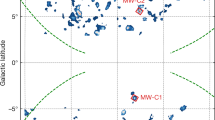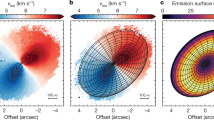Abstract
WHY is so little gas observed within globular clusters? A typical globular cluster contains ∼103 post-turn off stars, each of which will lose ∼0.2M⊙ before its asymptotic giant branch phase of evolution, and ∼0.1M⊙ during this phase1, and so should accumu-late 102∼103M⊙ of gas in the 108-year interval between passages of the globular cluster through the galactic disk. (At each disk passage, gas ram pressure will remove the accumulated material2,3.) But observational searches show that there is scant intracluster gas; in many clusters, there is less than 1M⊙ of gas, orders of magnitude less than theoretical predictions3. The recent discovery4,5 of multiple millisecond pulsars in globular clusters may resolve this long-standing problem: the relativistic wind from these pulsars is enough to drive gas from stellar mass loss out of the globular cluster.
This is a preview of subscription content, access via your institution
Access options
Subscribe to this journal
Receive 51 print issues and online access
$199.00 per year
only $3.90 per issue
Buy this article
- Purchase on Springer Link
- Instant access to full article PDF
Prices may be subject to local taxes which are calculated during checkout
Similar content being viewed by others
References
Iben, I. Jr & Renzini, A. Ann. Rev. Astr. Astrophys. 21, 271–342 (1983).
Roberts, M. S. in IAU Symp. 126: Harlow Shapley Symposium on Globular Cluster Systems in Galaxies (eds Grindlay, J. F. & Philip, A. G. D.) 411–423 (Kluwer, Dordrecht, 1986).
Taylor, R. J. & Wood, P. R. Mon. Not. R. astr. Soc. 171, 467–474 (1975).
Fruchter, A. S. & Goss, W. M. Astrophys. J. 365, L63–L66 (1990).
Manchester, R. N. et al. IAU Circ. No. 4905 (1990).
Roberts, M. S. Astr. J. 65, 457–466 (1960).
Kerr, F. & Knapp, G. R. Astr. J. 77, 573–576 (1972).
Knapp, G. R., Rose, K. W. & Kerr, F. J. Astrophys. J. 186, 831–839 (1973).
Bowers, P. F., Kerr, F. J., Knapp, G. R., Galiagher, J. S. & Hunt, D. A. Astrophys. J. 233, 553–557 (1979).
Lynch, D. K., Bowers, P. F. & Whiteoak, J. B. Astr. J. 97, 1708–1709 (1989).
Hills, J. G. & Klein, M. J. Astrophys. Lett. 13, 65–68 (1973).
Johnson, H. M., Catura, R. C., Charles, P. A. & Sanford, P. W. Astrophys. J. 212, 112–116 (1977).
Grindlay, J. E. & Liller, W. Astrophys. J. 216, L105–L109 (1977).
Troland, T. H., Hesser, J. E. & Heiles, C. E. Astrophys. 219, 873–876 (1978).
Schneps, M. H., Ho, P. T. P., Barrett, A. H., Buxton, R. B. & Myers, P. C. Astrophys. J. 225, 808–814 (1978).
Lynch, D. K. & Rossano, G. S. Astr. J. 100, 719–736 (1990).
Van den Bergh, D. A. & Faulkner, J. A. Astrophys. J. 218, 415–430 (1977).
Scott, E. H. & Durisen, R. H. Astrophys. J. 222, 612–620 (1978).
Frank, J. and Gisler, G. Mon. Not. R. astr. Soc. 176, 533–538 (1976).
Lea, S. M. & De Young, D. S. Astrophys. J. 210, 647–665 (1976).
Hartwick, F. D. A., Cowley, A. P. & Grindlay, J. E. Astrophys. J. 254, L11–L13 (1982).
Kulkarni, S. R., Narayan, R. & Romani, R. W. Astrophys. J. 356, 174–183 (1990).
Bietenholz, M. F., Kronberg, P. P., Hogg, D. E. & Wilson, A. S. Astrophys. J. 373, L59–L62 (1991).
Ruderman, M. & Cheng, K. S. Astrophys. J. 335, 306–318 (1988).
Kulkarni, S. R. & Hester, J. J. Nature 335, 801–803 (1988).
Gathier, R., Pottasch, S. R. & Goss, W. M. Astr. Astrophys. 127, 320–321 (1983).
Wolszczan, A. et al. Nature 337, 531–533 (1989).
Anderson, S. B., Kulkarni, S. R., Prince, T. A. & Wolszczan, A. Bull. Am. astr. Soc. 22, 1285 (1990).
Author information
Authors and Affiliations
Rights and permissions
About this article
Cite this article
Spergel, D. Evacuation of gas from globular clusters by winds from millisecond pulsars. Nature 352, 221–222 (1991). https://doi.org/10.1038/352221a0
Received:
Accepted:
Issue Date:
DOI: https://doi.org/10.1038/352221a0
This article is cited by
-
An intermediate-mass black hole in the centre of the globular cluster 47 Tucanae
Nature (2017)
-
New tools of the trade
Nature (1991)
Comments
By submitting a comment you agree to abide by our Terms and Community Guidelines. If you find something abusive or that does not comply with our terms or guidelines please flag it as inappropriate.



